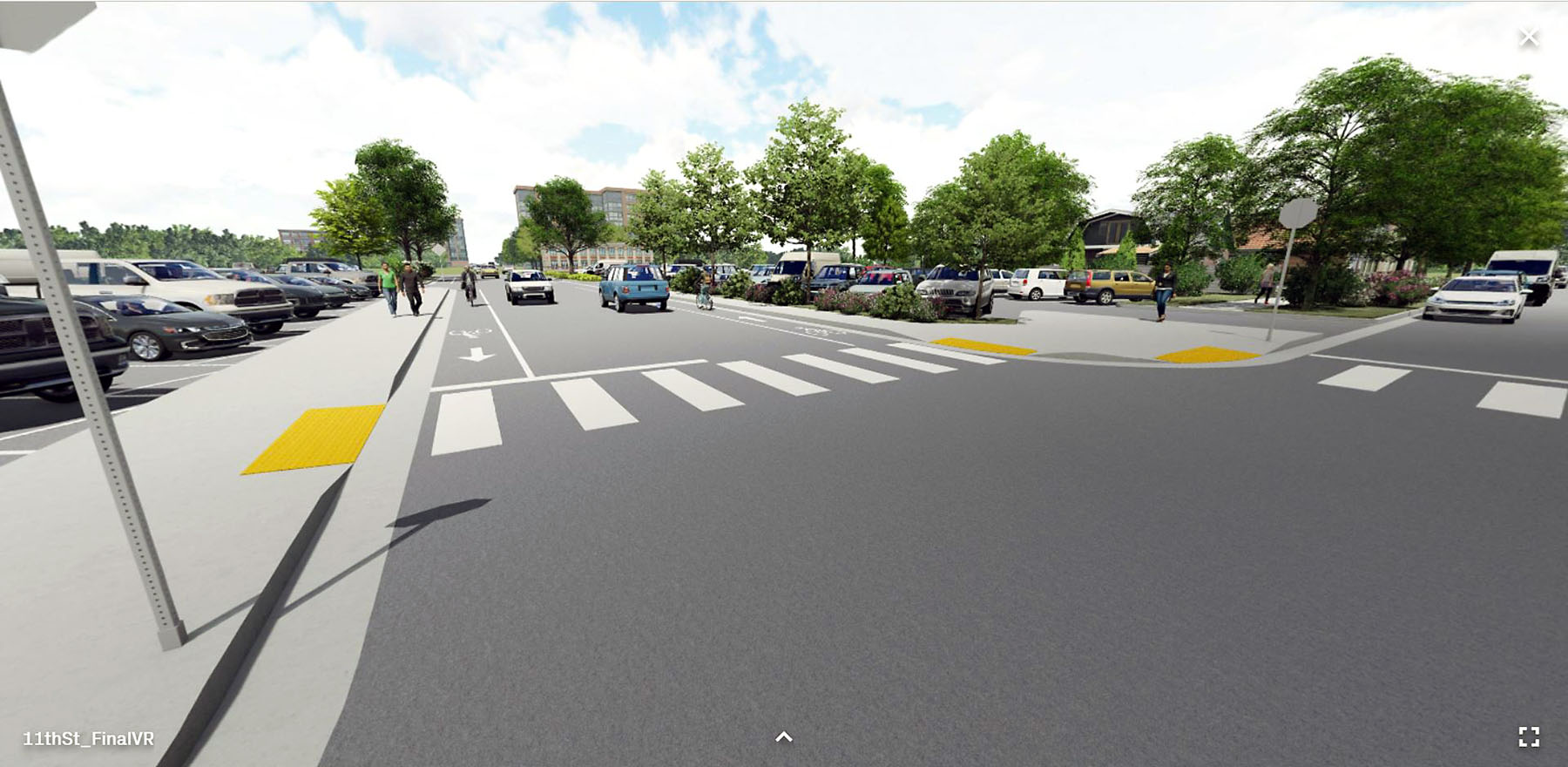
Virtual Reality Enhances Community Engagement
Virtual public involvement (VPI) is a rapidly growing and evolving method for encouraging community engagement that can take many forms. One emerging technology that shows promise in VPI applications is virtual reality (VR).
VR is a computer-generated, real-time virtual environment where users can experience a location in three dimensions without being physically present at the scene. Two main features of VR are immersion and virtual interactivity. These are accomplished by capturing the user’s hand, eye, and body movements and adjusting the immersive virtual environment accordingly.
VR is often experienced using a specialized headset normally composed of a stereoscopic head-mounted display, stereo sound, and motion-tracking sensors. The experience can be enhanced by accessories such as a joystick or glove, which give users basic interactivity with the environment, or by a full room dedicated to sensing user movement.
“Virtual reality can assist the public in having a more balanced perspective of the transportation decision-making process through interactive applications of the virtual environment,” said Mack Frost, FHWA transportation specialist and Every Day Counts round six (EDC-6) VPI team member.
Public Involvement Using Virtual Reality
Public involvement is an interactive process that engages the community in shaping or creating a vision for a transportation plan or project. Numerous strategies exist, from anonymous surveys to virtual public meetings. This type of creative outreach provides an excellent opportunity to collect feedback by reaching audiences who may not otherwise be interested in participating in the transportation planning and project development process.
Engaging with the public can be rewarding and fun, but also serves an important role during conceptualizing, developing, and implementing a project. Successful public engagement can lead to better project outcomes and help improve stakeholder understanding of, and support for, a project.
VR helps transportation professionals communicate their ideas and engage with the public during project demonstrations. Compared to traditional methods such as two-dimensional (2D) drawings, renderings, and 360-degree images, users can find it much easier to experience and explore a design, compare alternatives, brainstorm ideas, or point out specific elements of a project through an immersive virtual experience. Researchers have found that, compared to 2D plans on paper or 360-degree images on a computer screen, VR can increase civic participation in offering feedback on designing public spaces.
Iowa DOT’s VR headset enabled a fully immersive experience of a new bridge as part of its public involvement efforts on its I-74 bridge project.
Credit: Iowa Department of TransportationI-74 Mississippi River Bridge Replacement VR Demonstration
The Iowa Department of Transportation (DOT) collaborated with Iowa State University to develop a VR demonstration of the I-74 Mississippi River Bridge replacement project that attracted citizens to observe, advise, and provide feedback on the project.
The VR demonstration allowed users to experience the new design in different ways. They could drive or fly over the bridge, walk along its pedestrian path, or observe the view from its scenic deck. The demonstration also provided educational information about the river environment. Viewers could “dive” into the river and “pick up” mussels as a U.S. Fish and Wildlife Service biologist provided information about the species. Many of the mussels in the Mississippi River are considered threatened or endangered, so the Iowa and Illinois DOTs, along with the U.S. Fish and Wildlife Service and other agencies, conducted one of the largest mussel relocations in the United States prior to construction of the new bridge.
According to Annette Jeffers, automation engineer for the Bridges and Structures Bureau at Iowa DOT, the development of the 3D, fully immersive environment of the I-74 bridge replacement project cost less than $50,000. The 3D model of the bridge was developed by a consultant, while other 3D content for the simulation was designed by Iowa DOT and Iowa State University.
The Iowa DOT made the VR demonstration available at multiple locations across the city and supplemented it with public meetings and presentations. Project demonstrations were also uploaded on social media websites such as YouTube, where interested locals could leave comments.

Outreach for the Downtown 11th Street Bikeway study in Boise, ID, included 3D VR images to help the public visualize proposed improvements.
Credit: IrisVRBoise, ID, Downtown Bikeway Study
Not all VR demonstrations have to be as complex as a video or fully interactive environment. Sometimes, using VR to display a 360-degree, 3D image to the public can cause a concept to jump from the page to reality in the public’s mind.
In Boise, ID, 3D VR images were created for the Downtown 11th Street Bikeway study to show the public exactly how new intersections would look after the proposed improvements. The VR images were used in conjunction with an online survey to help plan the new bikeway.
Implementation Help Is Available
The EDC-6 VPI team supports agencies looking to implement innovative technologies such as VR into their public engagement strategy. They can provide resources and help make connections with other agencies who have successfully implemented VR to help agencies make an informed decision about adding it to their toolkit or to help implement it.
EDC Outtakes: VPI
Listen to your peers share insights on Every Day Counts innovations. In these editions, Eileen Barron of the Utah Department of Transportation (DOT) talks about how virtual public involvement tools such as videos and story maps have helped expand the agency’s reach, and Jamille Robbins of the North Carolina DOT describes how online tools have increased public participation on agency projects.
—MORE INFORMATION
Contact Lana Lau, Jill Stark, or Carolyn Nelson, FHWA EDC-6 VPI team co-leads, for information and technical assistance.
Notice: The U.S. Government does not endorse products or manufacturers. Trademarks or manufacturers’ names appear in this article only because they are considered essential to the objective of the document.
Recommended Citation: U.S. Department of Transportation, Federal Highway Administration - Washington, DC (2022) Innovator Newsletter, March/April 2022, Volume 15 (89). https://doi.org/10.21949/1521807



